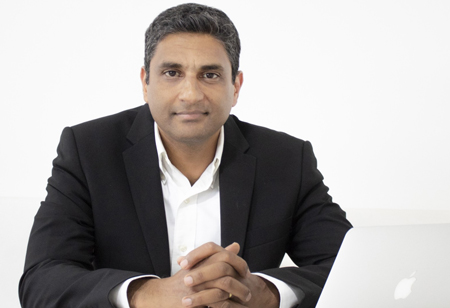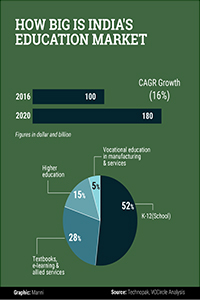
Current industry trends in education


An engineering graduate from BIT, and MBA from IIM-B, Seshasai is running the organization from the front.
The Indian Education sector is amongst the largest in the world, with an extensive network of more than 1.4 million schools (with over 200 million students enrolled) and more than 850 universities and 40,000 higher education institutes. Indian parents are increasingly realizing the need for new age education. This new trend is expanding rapidly in light of rising income levels and growing demand for new age education in the country. Further, India also has the world’s largest population in the age bracket three to 23 years which highlights the large addressable market for this sector.

The above graph indicates how the demand for education has increased between 2016 and 2020. While the demand for education had gone up significantly, the government hasn’t been able to build enough schools/institutions to support this demand across the country, hence private educational institutions have not just entered but bridged this gap and are here to stay. While private educational institutions are growing rapidly, there is one thing these institutions need to be mindful of which is to constantly stay ahead of time and innovate. Traditional methods of teaching and learning no longer excite parents and children.
This makes it even more challenging for us as educators as we need to keep track of the emerging trends and technological advancements in the education sector and at the same time ensure learning outcomes are not just met but aced by our children.
Some of the major trends in the education sector include:1.Personalised Learning: Over years researchers have proved that each child has a unique learning style. Some children are auditory learners, while some are visual learners etc. focusing on individual learning styles will help hone their talent and make them strong individuals. Hence schools should start shifting their focus towards personalising education for each child. Institutions are going an extra mile to ensure industry-best student-teacher ratios to enhance personalized learning.
2.Franchising in the Education Sector: Over the last decades, there has been an influx of a lot of standalone schools and preschools however people have realized that running a single/ stand along institution is way more tedious and they have started looking for organizations that offer a much more structured and ready-to-execute approach through brands offering school & preschool franchising. On the other hand, Institutions that have a strong setup have realized the need to take quality education far and wide in the country or across borders to increase our literacy levels and Franchising is one alternative to achieve that. Private players are now stepping into this space to multiply opportunities for growth.
3.Integrated Learning: In the past generations went through what we call ‘rote learning’, subjects were taught in isolation with not much focus on ‘actual understanding of concepts and topics’ rather memorization of topics and subjects. It has been noticed that this style of teaching does not help in understanding the concept being taught and a child only retains the information till the examination lasts. However when various subjects are integrated to teach certain concepts the child understands and retains the information for a longer duration. For E.g. While teaching Charlie and the Chocolate Factory in English language children can be taught math, business, economics and marketing etc. educational institutions and curriculum designers need to constantly innovate to ensure content is engaging for children. Also, teachers need to be trained to deliver this kind of curriculum to ensure it achieves the learning outcomes it is aiming to deliver.
4.Flipped Classrooms: Teaching young brains is an art, children retain more when learning is fun and stress-free. Flipped classrooms are one means of taking learning outside of the traditional classroom setup always helps. Students are introduced to content at home and practice working through it at school. This is facilitated by teachers sharing resource links, pre-recorded videos, YouTube videos about the subject/ topics are shared with students as pre-reads. And the practice or the actual work on the subject happens in the classroom through discussions, assignments that the class does once at school. This is the reverse of the more common practice of introducing new content at school, then assigning homework and projects to complete by the students independently at home.
5.Adapting to New Technological Advancements: Virtual Reality immerses the user in a virtual or imaginary environment. Immersive educational environments are already being used to provide learners with a life-like experience in subjects as diverse as history and chemistry. For example, Google Expeditions - visiting a museum, zoo through VR while sitting in class. Learning about geography and viewing different landscapes without actually stepping outdoors.
Gamification in Learning is another technological advancement to look out for. Children learn various concepts with the help of games. Instead of traditional rote learning, using video games and incorporating other game elements in education can motivate students to understand better and do well in their exams.
6.Remote Classrooms: Students can now do courses from their desired university whether in India or abroad. Technology has helped to bring classrooms to our living rooms. Thereby giving all students an equal opportunity to learn and grow in their careers.
7.Using Technology to Enhance Learning: Technology is now a necessity and children born in the 21st-century experience it from the time they are born. It is difficult to keep children away from it, the best way to use technology is to adapt it and use it to enhance a child’s learning experience. Today various schools and private players have developed apps where children can access games, activities, audios, and books related to what they are learning in class for a deeper understanding.
Over time we will the education sector taking bigger strides towards individualized learning. Enhancing learning outcomes for children is the end objective and as institutions we continue to find new ways to customize the learning experience for each child.
Technology and innovative teaching methodologies will play a big role in this continued shift. As the instruments we use advance, our approach to education will evolve into a more innovation-driven process.